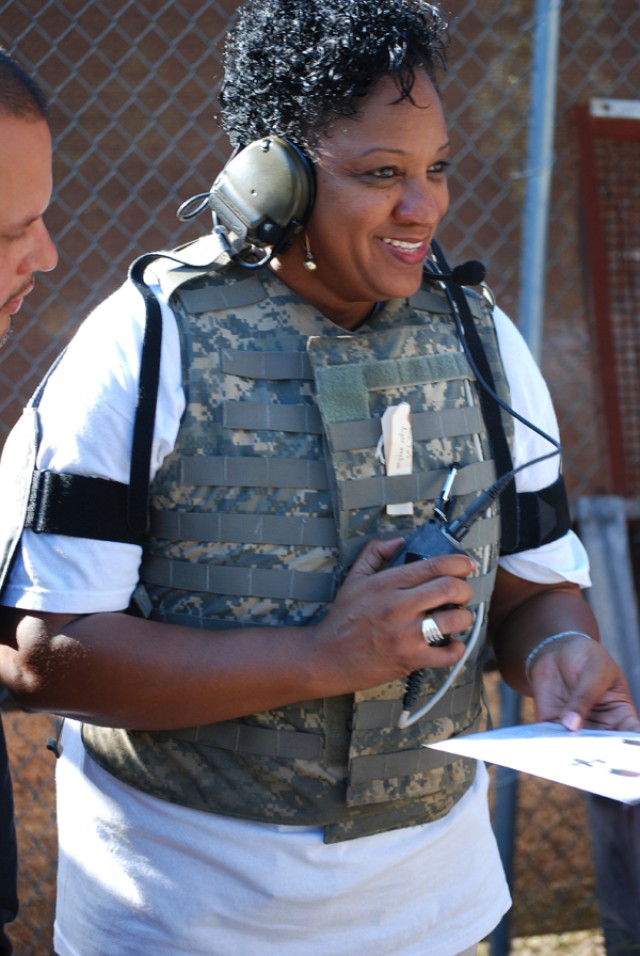The Wireless Network After Next (WNaN) is known for high performance in ever-changing circumstances.
So is its leader.
Flora Marshall, project leader for the intelligent, self-healing tactical network, has overcome challenges to shepherd the technology through its crucial assessment phase which is culminating this month as Soldiers evaluate WNaN at Fort Benning, Ga.
"She has really brought it to fruition," said Terry Claussen, deputy director of the Special Projects Office (SPO) for the Program Executive Office Command, Control and Communications - Tactical (PEO C3T). "She is pulling this all together."
WNaN, which was developed by the Defense Advanced Research Projects Agency (DARPA), is a battlefield network that can adapt to changing circumstances and keep radio communications intact. As Soldiers maneuver in complicated environments, WNaN automatically determines the best frequencies and the best path to utilize to maintain communications. It can also recover from signal disruptions and delays, potentially eliminating the need for Soldiers to stop and manually adjust frequencies during operations.
The PEO C3T is the executive agent for the Army in its agreement with DARPA to evaluate WNaN. Several other Army organizations are involved, with the Electronic Proving Ground out of Fort Huachuca, Ariz. collecting and analyzing data and the Maneuver Battle Lab at Fort Benning providing a realistic battlefield environment for WNaN experiments.
Anchoring it all is Marshall, who became project leader when the SPO took responsibility for WNaN just eight months ago.
"She is able to talk with the different organizations and work through and resolve issues (in ways) that are effective for the team, not just always one-sided," Claussen said. Those diplomatic skills, he said, have enabled the complicated WNaN effort "to move forward as efficiently as possible."
Marshall has also teamed with DARPA to find efficiencies and share costs between that agency and the Army, Claussen said.
In addition to cooperating with external organizations, Marshall oversees a team of about 20 people - no easy task during the upheaval of the Base Realignment and Closure (BRAC) process, which is transferring PEO C3T and several other Army organizations from Fort Monmouth, N.J. to Aberdeen Proving Ground, Md.
"Her key accomplishment is being able to keep the team together," Claussen said. "We've had some change in personnel, but her ability to integrate those people into the team and keep the overall process moving forward has been outstanding."
Marshall guided WNaN over a key hurdle in July and August, when WNaN demonstrated its potential during field evaluations conducted at Fort Devens, Mass. The technical assessment included a demonstration of a 52-node network that highlighted WNaN's high voice quality, frequency agility and message completion.
This fall at Fort Benning, Soldiers with the Training and Doctrine Command (TRADOC) Experimental Force are conducting a series of operations to gauge WNaN's performance in various "missions" and combat environments. Every step of the way, the Soldiers' verbal feedback is collected and matched up with audio and video capture from the missions, as well as technical data generated by the Multiple Integrated Laser Engagement System (MILES).
Army senior leaders also attended a VIP day at Fort Benning to watch WNaN in action. The experimentation wraps up in mid-November, and the findings will be incorporated into a final WNaN evaluation report. The PEO C3T and other organizations will then craft recommended transition strategies for incorporating the technology into the Army's plans.
Marshall will also lead that effort, which will culminate with a briefing to the Vice Chief of Staff of the Army that is tentatively planned for March 2011, Claussen said. Whatever WNaN's future, he said, Marshall will be ready to adapt to it.
"Ms. Marshall is a consummate professional and a true team player," said Richard Costa, director of the SPO. "Her contributions have been instrumental in the successes associated with WNaN to date."


Social Sharing